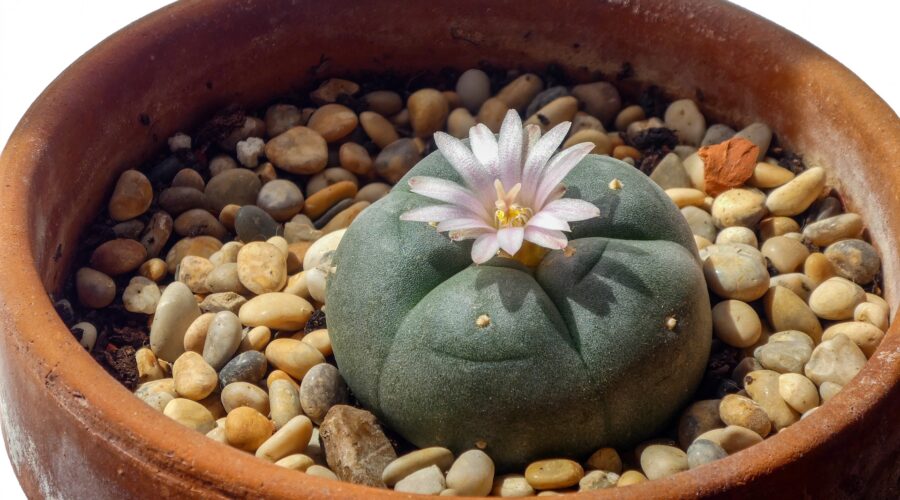What Is Peyote And How Does It Work?
Peyote (Lophophora williamsii) is a small cactus that contains the psychedelic compound mescaline. It has a rich history of traditional use by indigenous North Americans. The Native American Church (NAC) also uses the cactus as a religious sacrament today.
In this post, we will detail the characteristics of the peyote cactus, its history of use, its current usage, and how it delivers a psychedelic experience.
RELATED: What Is LSA? Your Guide To The Complicated Psychedelic
What Is Peyote?
Peyote is one of several species of mescaline-containing cacti, with some other examples including the San Pedro cactus (Echinopsis pachanoi) and the Peruvian Torch cactus (Echinopsis peruviana).
The Size Of Peyote
San Pedro and Peruvian Torch are much larger than peyote. The latter averages about eight centimeters (three inches) wide and five centimeters (two inches tall). San Pedro, meanwhile, grows up to 300-600 centimeters tall and 150-180 centimeters wide.
Its Appearance
Peyote is a spineless cactus, with a distinctively small, green, and globular appearance. It consists of peyote buttons: these disc-shaped buttons are the top of the cactus. They contain mescaline, as well as other alkaloids. Sometimes, peyote will produce pink flowers which then become club-shaped, edible pink berries.
Where It Grows
The three types of cacti grow in different locations:
- Peyote is native to Mexico and southwestern Texas
- San Pedro is native to the Andes Mountains, growing at an altitude of 2,000-3,000 meters, and is found in Argentina, Bolivia, Colombia, Chile, Ecuador, and Peru
- Peruvian Torch, as the name suggests, is native to Peru (specifically the western slope of the Peruvian Andes)
The Mescaline Content Of Peyote
The mescaline content of peyote is 0.4 percent in fresh cactus and 3-6 percent in dried cactus. Peyote has the highest concentration of mescaline in a cactus by weight.
The History Of The Drug
Dried peyote buttons have been discovered in Shumla Cave No. 5 on the Rio Grande, Texas, dating to 3780-3660 BC. These samples contained a mescaline concentration of two percent, the same found in many dried peyote buttons today. This shows just how stable this compound is. (The concentration of mescaline in these buttons could have been higher 5,700 years ago, so there may have been a loss in potency.) The authors of this research state the following:
“The two peyote samples appear to be the oldest plant drug ever to yield a major bioactive compound upon chemical analysis. The identification of mescaline strengthens the evidence that native North Americans recognized the psychotropic properties of peyote as long as 5700 years ago.”
The Aztecs used peyote. The name “peyote” is a Spanish word, which comes from the Nahuatl peyōtl (meaning “caterpillar cocoon”). The Spanish missionary priest Bernardino de Sahagún, who studied the indigenous peoples of Mexico in the 1500s, said of peyote:
“There is another herb like mountain prickly pear, named peiotl, which is white and can be found in the north. Those who eat or drink of it see terrifying or absurd visions; this inebriation lasts two or three days and then subsides. It is a delicacy often enjoyed by the Chichimeca, for it is sustaining and spurs them to fight with no thought of fear, thirst, or hunger, and they say that it protects them from all danger.”
The Drug’s Introduction Sparked Controversy
Other Spanish missionaries discussed the use of peyote among the Aztecs and indigenous peoples of Mexico, including Francisco Hernández and Juan de Cárdenas, with the latter describing its effects negatively (as the Spanish missionaries generally did):
“In sooth they tell us that peyote, and ololiuhque [the seeds of which contain the psychedelic drug LSA], when taken by mouth, will cause the wretch who takes them to lose his wits so severely that he sees the devil among other terrible and fearsome apparitions; and he will be warned (so they say) of things to come, and all this must be tricks and lies of Satanas, whose nature is to deceive, with divine permission, the wretch who on such occasions seeks him”.
Native users of peyote were persecuted as a result of the Mexican Inquisition, an extension of the Spanish Inquisition to New Spain (Mexico). Ecclesiastical opposition to the cults involving peyote was strong. In 1720, Mexico began prohibiting peyote use. This forced the indigenous peoples of Mexico to practice their peyote rituals in secret.
RELATED: San Pedro Cactus (Echinopsis Pachanoi) – Uses, Legality And More
What Is Peyote Used For Today?
Currently, the Tarahumara, Tepehúan, and Huichol peoples of northern Mexico, as well as the Navajo and Comanche in the southern United States, use peyote in a ritualistic setting for the purposes of healing and making contact with the spirit world.
While peyote use is illegal in the United States (since mescaline is a Schedule I drug), members of the NAC have legal permission to use the plant as part of their religious ceremonies. The NAC is a syncretic religion that has been around since the 19th century, and combines Native American beliefs with Christianity. Peyote is central to the religion, also known as Peyotism or Peyote Religion.
The NAC is a Pan-Indian religion, meaning that people many different Native American tribes are members. Church membership is restricted to only Native Americans. Adherents use peyote to communicate with the Great Spirit (a supreme being), also referred to as the Creator in the NAC religion. The all-night peyote ceremonies take place in tipi tents and consist of prayer, drumming, singing, scripture reading, sacramental consumption of peyote, and contemplation.
It is possible to consume peyote if you’re not a member of the NAC, or a tribe that the Mexican government gives permission to harvest and use it (such as the Huichol). However, doing so is illegal. Many people travel to Mexico and to locations in Texas, where peyote grows to harvest the cactus for use. But this has resulted in the problem of overharvesting, with peyote now listed as vulnerable in the International Union for Conservation of Nature (IUCN) Red List of Threatened Species, which means the cactus faces a high risk of extinction in the wild.
Cultivating From Home Takes Years
People do also cultivate at-home peyote, but it is a slow-growing cactus. If you were to cultivate it, it would take six to 12 years to grow from seed to mature adult. However, it can grow faster in a controlled environment, taking only a few years. Meanwhile, in the wild, peyote takes up to 30 years to reach maturity. For this reason, harvesting large quantities of it in the wild in an unsustainable way threatens the ability of the Huichol Indians to continue using the plant.
The author and psychedelic advocate, Tim Ferriss, has argued that, since peyote is nearly extinct and takes decades to regrow, people should consider using the San Pedro cactus or synthetic mescaline instead. He points out that using peyote harvested from the wild entails ecological, ethical, and cultural challenges.
How Does Peyote Work?
Now, let’s turn to the topics of how to consume peyote and how the drug induces a psychedelic experience.
How To Consume Peyote
You would normally prepare peyote for consumption by cutting the buttons from the plant. They can then be dried and eaten — however, they often have a bitter, unpleasant taste. To get around this problem, you can grind up the dried buttons and mix the powder with juice or put the powder in some empty capsules to swallow. You can also boil the buttons in water to produce a tea.
The amount of peyote you should consume depends on the size of the cactus and the kind of experience you want.
Size: 3-4 cm
– Light: 3-6 buttons
– Common: 6-12 buttons
– Strong: 8-16 buttons
– Heavy: 15+ buttons
Size: 5-6 cm
– Light: 2-5 buttons
– Common: 5-9 buttons
– Strong: 7-12 buttons
– Heavy: 12+ buttons
What Happens After Consuming It?
When consuming peyote, your body begins digesting the plant material. During this stage, it is common to experience nausea, occurring within 30 minutes of ingesting the plant. The stomach digests the drug’s components, then travels through the intestinal tract. This is where rapid absorption of mescaline occurs. The mescaline gets processed through the pancreas, liver, kidneys, and spleen, after which it binds to various receptors in the brain.
Mescaline — along with other classic psychedelics like LSD, psilocybin, and DMT — is a serotonergic psychedelic. This means it acts on the serotonin receptors in the brain. Like these other psychedelics, mescaline causes psychedelic effects by binding to the serotonin 5-HT2A receptor. Mescaline also stimulates dopamine receptors and the serotonin 5-HT2C receptors. Scientists have observed that mescaline’s effects are dependent upon the stimulation of both the serotonin and dopamine receptors.
When mescaline binds to these receptors, you can experience a range of perceptual, emotional, spiritual, and physical effects. These can include the below.
- Changes to visual, auditory, or tactile perceptions
- Visual and/or auditory hallucinations. These can include visions of fractal and geometric patterns or the perception of visual scenes playing out
- Emotions like euphoria, joy, bliss, love, gratitude, anxiety, and fear
- Mystical states, including features like ego loss, a sense of sacredness, the feeling of a divine presence, timelessness, ineffability, and a feeling of unity or interconnectedness
- Physical sensations such as increased stimulation and physical euphoria
Taking peyote is, for many people, an extremely therapeutic and life-changing experience. As with all psychedelics, remember to take it responsibly and with proper guidance.




Robert Garza
September 28, 2021 at 6:03 amExcellent article, very close to the real experience. Very very descriptive.